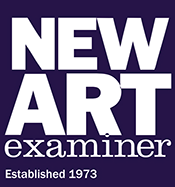
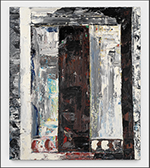

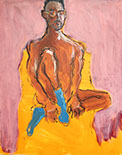
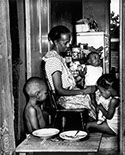
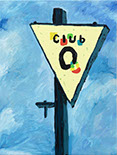
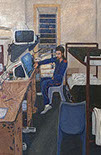
“Envision: The Michigan Artist Initiative 2023”
by K.A. Letts
“Envision: The Michigan Artist Initiative 2023,” an exhibition and awards program sponsored by the University of Michigan’s Penny Stamps School of Art and Design, showcases the excellence and artistic merit of three mid-career artists working in the metro Detroit area. But it does more than that. It also serves as an illustration of current trends in contemporary art practice. The three finalists, Bakpak Durden, Levon Kafafian and Parisa Ghaderi, in addition to creating well-conceived and highly personal work, can also be said to check all the boxes that characterize contemporary art preoccupations at this moment: gender fluidity and non-conformism, check; ethnic and racial diversity, check; political advocacy, check; multi-disciplinary art practice (with accompanying technological bells and whistles), check. One of the three finalists will be selected as the winner of this year’s competition with an accompanying $5,000 cash prize. But all three have already won, in a sense, having been chosen from a field of 309 applicants for the prize.
The three-person exhibition that accompanies “Envision,” now on view through July 31st at the Penny Stamps Gallery in Ann Arbor Michigan, is illuminating in ways both intended and unintended. The atmosphere that permeates the work in the exhibition is one of dislocation and strangeness—an effect totally appropriate to the confusing time in which we find ourselves as a nation and as a community of artists. Unidentified locations, unknown identities, overheard conversations in unknown languages, and unfamiliar melodies from the finalists contribute to a sense of intrigue calculated to unsettle and disorient.
In the front gallery, highly accomplished representational paintings and grainy, atmospheric photographs by BakPak Durden spotlight the artist’s virtuosic work, which often references established traditions of painting and art history. Durden is a native of Detroit, self-taught, who has absorbed lessons from the masters they have studied—Caravaggio, Rembrandt, and van Eyck—and has repurposed their renaissance and baroque esthetic in the development of a personal iconography of sharp, slender triangles and lines that float through lushly painted compositions. The result is a subtly surreal evocation of the artist’s fragile liminal state, one which they describe as an acute sensitivity to Black transness, queerness, variable states of mental health and neurodiversity.
Durden has found a warm welcome for their accomplished figurative paintings, murals and photographs among the artists, museums, and galleries in Detroit. Their work first came to public attention in 2021, when they took part in the inaugural BLKOUT Walls festival with their Evocative of Ingenuity mural. They were awarded a Kresge Foundation Gilda Award in 2021 for visual art, as well as a 20/20 Emerging Artists Fellowship from Playground Detroit in the same year. A solo exhibition of their work at the Cranbrook Art Museum, “The Eye of Horus,” opened in November of 2022.
“Envision” opens with Durden’s wall-size mural depicting the artist’s hand clutching a workman’s coat, a motif that recurs throughout their portion of the exhibition. The upper part of the mural is painted in color, then repeated below and in the foreground in grisaille. Narrow bands slice through the doubled images and attach them to a smallish painting hung nearby as well as to the accompanying artist’s statement.
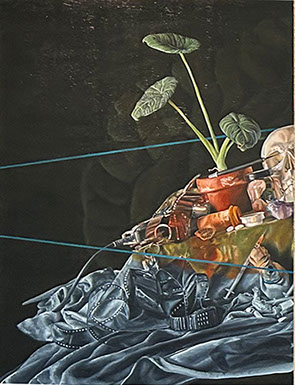
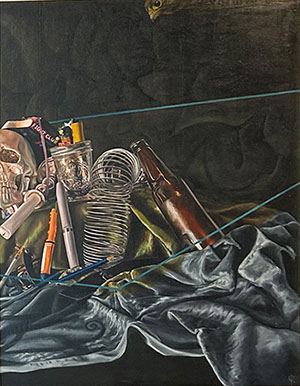
Bakpak Durden (Left panel), Double Crown of the Distant One (diptych), 2022. (Right panel), Double Crown of the Distant One (diptych), 2022, oil and archival ink on wood panel, each side, 48 x 36 inches (48 x 72 inches overall). Photos: K.A. Letts.
Double Crown of the Distant One, a diptych hung on two adjoining walls, illustrates many of Durden’s methods and preoccupations. A kind of vanitas painting, the composition is crowded with emotionally resonant, yet cryptic, elements. A bisected skull shares space with a slinky toy, a potted plant rests near pharmaceutical bottles and syringes. There is humor here, and desperation. The doubled composition starts in color at the top of the 2 paintings and leaches into black and white toward the lower edges, suggesting the conventional material world in transition to its ghostly echo.
Durden’s work is firmly rooted in the environs of Detroit and its post-industrial landscape, as the city returns to its natural state. Several of the paintings and photographs use the interiors of cars as framing devices. Durden routinely juxtaposes blue-collar clothing, work tools and everyday environments with the elegance of the artist’s technically accomplished painting in a potent combination of the humble and the sublime.
In contrast to Durden’s art history inspired paintings, the middle space of the Penny Stamps Gallery is occupied by the playful visual storytelling and world building of Levon Kafafian, an Armenian American native of Detroit who holds a BFA in crafts from he College for Creative Studies. They inventively exploit the formal possibilities of thread, beads and fabric to create costumes and artifacts for the inhabitants of an imaginary place they call Azadistan, where a tale unfolds of “blurred boundaries, false borders and questions of cross-cultural coexistence.” The objects on display in the exhibit support a developing story—yet to be written—entitled Portal Fire. This sprawling project is represented in the gallery by 5 costumed avatars and several artifacts and amulets that pertain to their identities, as well as woven tapestries that provide a background for each figure. The archetypes represented are four out of 12 spirits of Azadistan who populate the tale and move the story forward with their special attributes. Anarad, the Serpentine Spirit, “embodies the never-ending Serpent… who imbues the snake clan with the power to wield fire magic in emerald and jade hues.” Vartahan, The Flaming Rose, is a mischievous trickster who enjoys manipulating human emotions, sensuality and fertility. Vanagad, the Obsidian Spirit, has twin bodies, and the Summoner is a mysteriously hooded traveler. Kafafian has chosen the dubious strategy of providing voluminous supporting material for this imaginary world by means of the dreaded QR code (15 of them!) ensuring that you will spend the bulk of your time in this section of the exhibition looking at the screen of your cell phone. Which is too bad, because the objects in the exhibit are beautifully crafted and intriguing in their own right, visual representations of a very much larger project that wants to be a graphic novel—or an epic film.
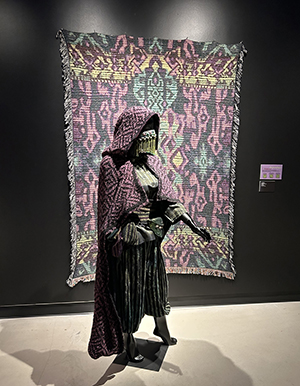
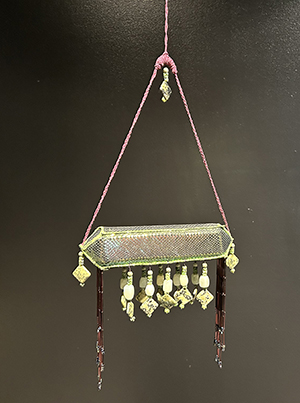
Levon Kafafian (Left), The Summoner, 2022, cloak-handwoven in hand-dyed cotton, rayon, applied trim and found fabric lining; mask/veil-leather, o-rings, pyramid studs, hand applied beads and evil eyes; tunic-sewn in found fabric; belt/satchel-assembled leather, jewelry, hardware; pouches-handwoven wool, cotton, rayon and cord; pants-handwoven in hand dyed cotton, rayon with found fabric waistband; staff-found wood, whittled and dyed, applied beads and thread. (RIght), The Wildfire Amulet, 2023, leather, beads, metal, cord and foam, 21 x 11 x 2.5 inches. Photos: K.A. Letts.
From the rich fantasy world of Kafafian’s Azadistan, you will be plunged into darkness, both literally and figuratively, by the austere journalistic photographs of Iranian-born artist Parisa Ghaderi. Ghaderi studied graphic design and visual communication in Tehran and, since her immigration to the U.S., has earned an MFA in 2014 from the Penny Stamps School of Art. For dancing in the streets is an installation of five projected, large format black and white images of the recent Iranian “Women, Life Freedom” protests which began in September 2022. The oversize static images contain smaller inset videos of dancing protesters who face imprisonment and worse from a government that employs all the power of the state to police challenges to their socially and religiously repressive system. Each photograph is framed by a pair of hands, a reference to the “mourning mothers” who attend the protests to hold up pictures of their children killed by the regime. The dancers in the videos, mostly women, defy the misogyny of their government through movement. Lest there should be any doubt that there is an ongoing government effort to quell dissent, the New York Times on June 11 reported that two female journalists are now on trial for publicizing the death of Mahsa Amini, the incident that set off the protest movement in 2022.
The jury for “Envision 2023,” Neil A. Barclay of the Charles Wright Museum of African American Art, Shannon Rae Stratton of the Ox-Bow School of Art and last year’s prize winner, Navda Collazo-Llorens, face a daunting task—to select one winner out of the three accomplished finalists for the 2023 Envision Prize, which will be awarded on June 29, 2023. Bakpak Durden, Levon Kafafian and Parisa Ghaderi, have all presented technically accomplished work that expresses—each in its own way—the esthetic pluralism of the contemporary art world at this moment. Their artworks illuminate not only their individual excellence but provide a snapshot of the cultural moment we find ourselves in now—one of confusion, dislocation, and possibility.
K.A. Letts is the Detroit editor of the New Art Examiner, a working artist (kalettsart.com) and art blogger (rustbeltarts.com). She has shown her paintings and drawings in galleries and museums in Toledo, Detroit, Chicago, and New York. She writes frequently about art in the Detroit area.
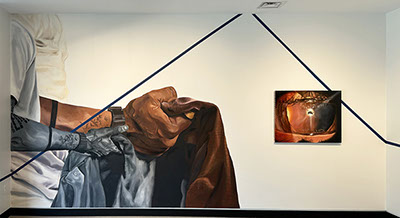
Bakpak Durden, gallery installation. Photo: K.A. Letts.
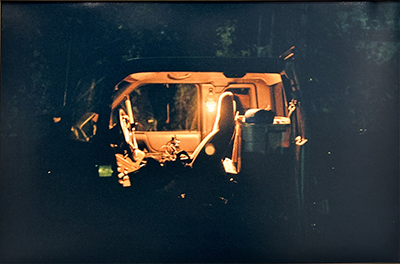
Bakpak Durden, Elude to Reserve (printed 2023), framed archival print from original negative, 30 x 40 inches. Photo: K.A. Letts.
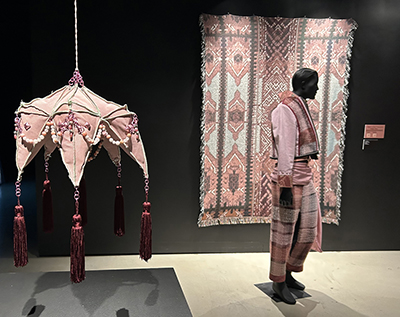
Levon Kafafian, The Flaming Rose, 2023, (left) leather, thread, beads, acrylic metal, handwoven silk, rayon, cotton and foam, 18 x 20 x 16 inches, (right) jacket-handwoven in cotton, rayon, linen, silk and bamboo; hardware, applied trim and found fabric lining; vest-found fabric and hardware; pants-handwoven panels of cotton, rayon, linen, silk, nylon, bamboo with found fabrics; shirt-found dyed garment; sash, silk trim; choker-leather, hardware. Photo: K.A. Letts.
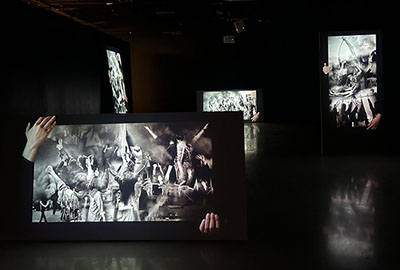
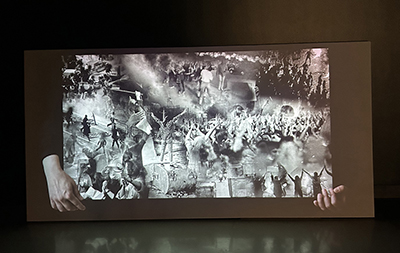
Parisa Ghaderi (Above), For dancing in the streets, 2022. Gallery installation, projected video image and video. (Below), For dancing in the streets, 2022, projected video image and video. Photos: K.A. Letts.